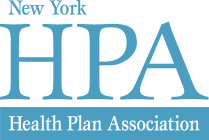MEMORANDUM IN OPPOSITION
FOR IMMEDIATE RELEASE: APRIL 29, 2019
Re: S.2849 (Breslin)/A.2969 (Peoples-Stokes) – An act to amend the insurance law and the public health law, in relation to prescription drug formulary changes during a contract year.
This legislation would prohibit health insurance plans from making mid-year pharmacy formulary changes, which will result in higher health insurance premiums and exacerbate the increasing cost of drugs − one of the fastest rising components of health care costs. For these reasons, the New York
Health Plan Association (HPA) opposes S.2849/A.2969.
Specifically, this legislation would prohibit health plans from making changes to their formularies
except during the renewal and enrollment period leading up to the start of an employer’s or individual’s policy year. Additionally, the bill would require health plans to provide advance notice of the intent to remove a drug from the formulary or alter its tier.
Restricting formulary changes to the start of the policy year will lead to higher costs for employers and consumers. Individuals and employers renew policies at different times over the calendar year, typically at the beginning of each month. “Locking-in” the formulary when the policy year begins would have the unintended result of creating multiple formularies each month for each new or renewing policy. The practical effect of this bill would be the creation of multiple formularies with differing coverage of medications dependent on when a policy renews, which will promote confusion among consumers, physicians and pharmacies, and significantly drive up health plan administrative costs.
Additionally, this bill is unnecessary as protections already exist for consumers. Currently, the
Department of Financial Services limits how often plans may update formularies to no more than six
times a year. However, health plans typically make changes less frequently and rarely remove drugs
from the formularies. Further, when an individual’s drug changes to higher tier, or when a drug has been removed from the formulary, there must be a therapeutic equivalent drug that is as effective as the original drug. In all cases, plans must notify affected members about the formulary changes. Moreover, New York law requires plans to have “exception” processes that enable consumers or their providers to access specific treatments, including prescription drugs. This ensures members get the most effective drugs regardless of whether the drug is on the formulary.
Decisions to update a health plan’s drug formulary or to change tiers are determined by health plans’
Pharmacy and Therapeutic (P&T) committees. Comprised of independent community physicians and
pharmacists with expertise in the diagnosis and treatment of disease, these committees review new drugs and the latest clinical information to determine which drugs will appear on the formulary. This ensures that there is local input into a health plan’s formulary and that members have access to needed medications while also helping to reduce the cost of member premiums, incentivize use of the most effective drugs, and ensure patient safety.
Formularies have existed for decades and are commonly used by hospitals, health plans, prescription benefit management companies, self-insured employers, and government programs. Formularies are designed to provide enrollees access to effective drugs in every therapeutic class to ensure efficacious treatment while managing the rising cost of medications. The formulary and review process of modification is intended to reduce the cost of member premiums, incentivize use of the most efficacious drugs, and ensure patient safety.
Increased utilization, price inflation, and higher cost drugs continue to drive up prescription drug costs. Drug companies are pushing the limits on prescription drug prices across the board. Six-figure price tags on old and new drugs have become commonplace, specialty drugs and generic drugs see similar pricing jumps, and prices for orphan drugs regularly reach above $300,000. To counter these increases and to keep prescription coverage affordable for consumers, health plans use comprehensive prescription drug formularies.
By “locking-in” the formulary of covered drugs, the legislation would prevent the continuous review, update, and change necessary to maximize premium affordability, safety, and efficiency to benefit consumers. We do not believe it is in the best interest of the health plans or the patients served to prohibit a health plan from acting to incentivize use of the most efficacious drugs and reducing the cost of member premiums by changing its formulary mid-year.
At the federal level, the Department of Health and Human Services (HHS) had considered restricting mid-year formulary changes in its January 2019 Proposed Notice of Benefit and Payment Parameters for 2020. However, in the final notice released on April 19, 2019, HHS chose not to prohibit mid-year formulary changes, announcing that it would study the issue further due to “the complexity of this issue, and the challenges of balancing the interests of consumers with the importance of mitigating the effects of rising prescription drug costs.” Instead, HHS noted that it expected health plans that chose to make mid-year formulary changes should have their P&T committees pre-approve any changes, provide advance notice to individuals, and have an appeals and exception process in place. Given the actions at the federal level and that New York health plans have in place the protections that HHS recommends, this legislation is not necessary.
For all these reasons, HPA opposes S.2849/A.2969.
